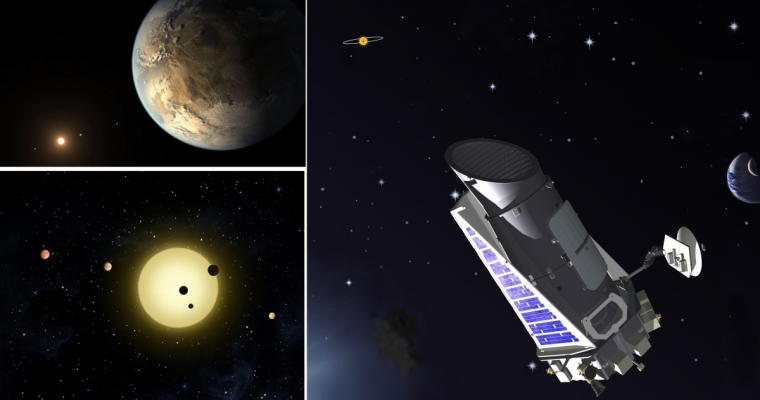NASA Finds New Earth-Like Planet After Saving Kepler Space Telescope Mission

Down but not out, a battered NASA space telescope has just discovered another planet similar to Earth where life is possible some 180 light years away from our planet in the Pisces constellation.
The telescope-carrying Kepler spacecraft was launched in 2009 with the mission to find Earth-like planets in our Milky Way galaxy. For four years, Kepler stared at one spot in the sky where some 150,000 stars lie to see if any planets passed in front of them. The mission quickly yielded positive results as Kepler discovered a number of Earth-like worlds orbiting distant stars.
However in May 2013, one of the telescope's four reaction wheels, which kept it focused on one spot in the sky, malfunctioned. This rendered the spacecraft unstable and unable to focus on its target.
After studying different ways of resolving the problem, NASA scientists came up with a brilliant idea. They ingeniously maneuvered the crippled spacecraft so that pressure from the sunlight hitting the spacecraft's solar panels acts as a crutch for one of its busted legs. This stabilized the spacecraft, enabling Kepler to resume its planet-hunting mission.
Since the spacecraft is now dependent on an exact position for sunlight to hit its panels, the scientists have to readjust the spacecraft every 80 days. This necessitated a change in its concept. Instead of fixing its gaze at just one point in the sky as was its previous mandate, the spacecraft can now focus on any potentially interesting objects in the sky in search of planets.
Under this new program called K2, the space telescope discovered the exoplanet known as HIP 116454b.
The planet is a Super Earth about 2.5 times bigger than our world. It's a type of planet that doesn't exist in our solar system, scientists say. It sits very close to its bright star near the constellation Pisces, completing a "year" in just 9.1 days. Based on its mass, the planet could either be a watery world -- one-quarter rock, the rest water -- or a mini-Neptune with a thick, gassy atmosphere, said Andrew Vanderburg, an astronomer at the Harvard-Smithsonian Center for Astrophysics.
This planet could be a good future target for the Hubble Space Telescope, or for the James Webb Space Telescope, set for launch in 2018. In the meantime, more K2 data should be coming in the next month or so, Vanderberg said.
NASA says with the reinvigorated Kepler planet-hunting mission, new worlds where life could potentially exists await to be discovered.
"K2 is uniquely positioned to dramatically refine our understanding of these alien worlds and further define the boundary between rocky worlds like Earth and ice giants like Neptune," said Kepler/K2 project scientist Steve Howell.
 Christians don't have to affirm transgenderism, but they can’t express that view at work: tribunal
Christians don't have to affirm transgenderism, but they can’t express that view at work: tribunal Archaeology discovery: Medieval Christian prayer beads found on Holy Island
Archaeology discovery: Medieval Christian prayer beads found on Holy Island Presbyterian Church in America votes to leave National Association of Evangelicals
Presbyterian Church in America votes to leave National Association of Evangelicals Over 50 killed in 'vile and satanic' attack at Nigerian church on Pentecost Sunday
Over 50 killed in 'vile and satanic' attack at Nigerian church on Pentecost Sunday Ukrainian Orthodox Church severs ties with Moscow over Patriarch Kirill's support for Putin's war
Ukrainian Orthodox Church severs ties with Moscow over Patriarch Kirill's support for Putin's war Islamic State kills 20 Nigerian Christians as revenge for US airstrike
Islamic State kills 20 Nigerian Christians as revenge for US airstrike Man who served 33 years in prison for murder leads inmates to Christ
Man who served 33 years in prison for murder leads inmates to Christ


 Nigerian student beaten to death, body burned over ‘blasphemous’ WhatsApp message
Nigerian student beaten to death, body burned over ‘blasphemous’ WhatsApp message 'A new low': World reacts after Hong Kong arrests 90-year-old Cardinal Joseph Zen
'A new low': World reacts after Hong Kong arrests 90-year-old Cardinal Joseph Zen Iran sentences Christian man to 10 years in prison for hosting house church worship gathering
Iran sentences Christian man to 10 years in prison for hosting house church worship gathering French Guyana: Pastor shot dead, church set on fire after meeting delegation of Evangelicals
French Guyana: Pastor shot dead, church set on fire after meeting delegation of Evangelicals ‘Talking Jesus’ report finds only 6% of UK adults identify as practicing Christians
‘Talking Jesus’ report finds only 6% of UK adults identify as practicing Christians Mission Eurasia ministry center blown up in Ukraine, hundreds of Bibles destroyed: 'God will provide'
Mission Eurasia ministry center blown up in Ukraine, hundreds of Bibles destroyed: 'God will provide' Church holds service for first time after ISIS desecrated it 8 years ago
Church holds service for first time after ISIS desecrated it 8 years ago Burger King apologizes for 'offensive campaign' using Jesus' words at the Last Supper
Burger King apologizes for 'offensive campaign' using Jesus' words at the Last Supper Uganda: Muslims abduct teacher, burn him inside mosque for praying in Christ’s name
Uganda: Muslims abduct teacher, burn him inside mosque for praying in Christ’s name